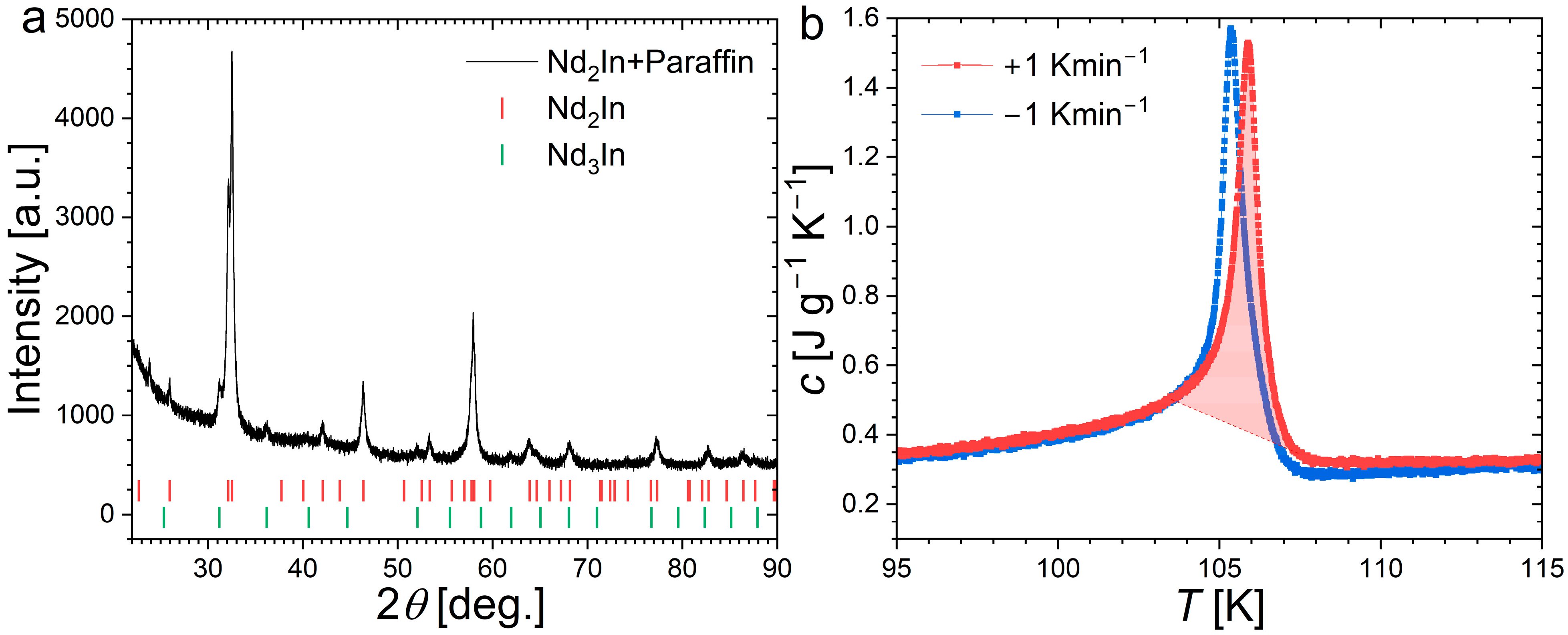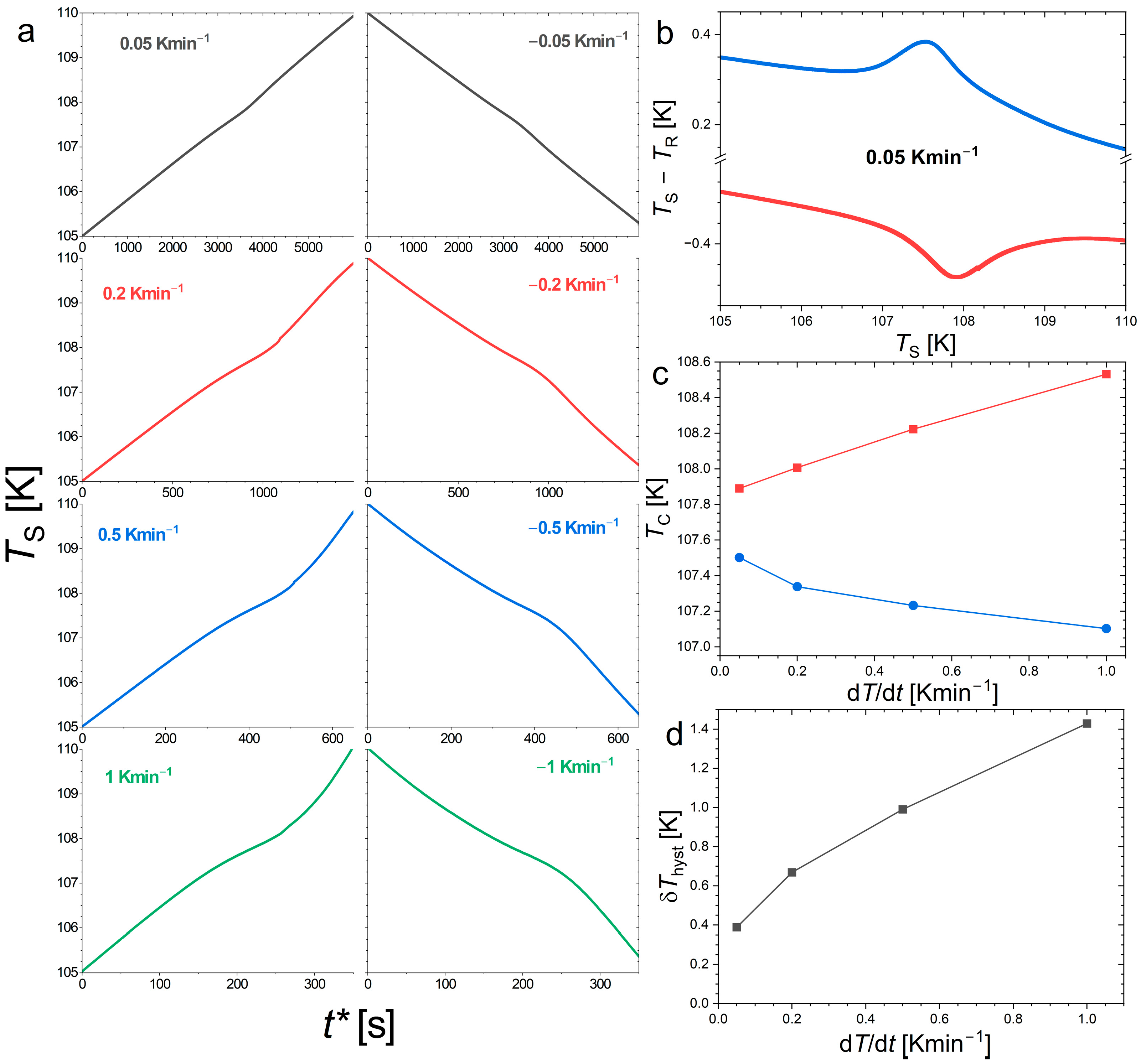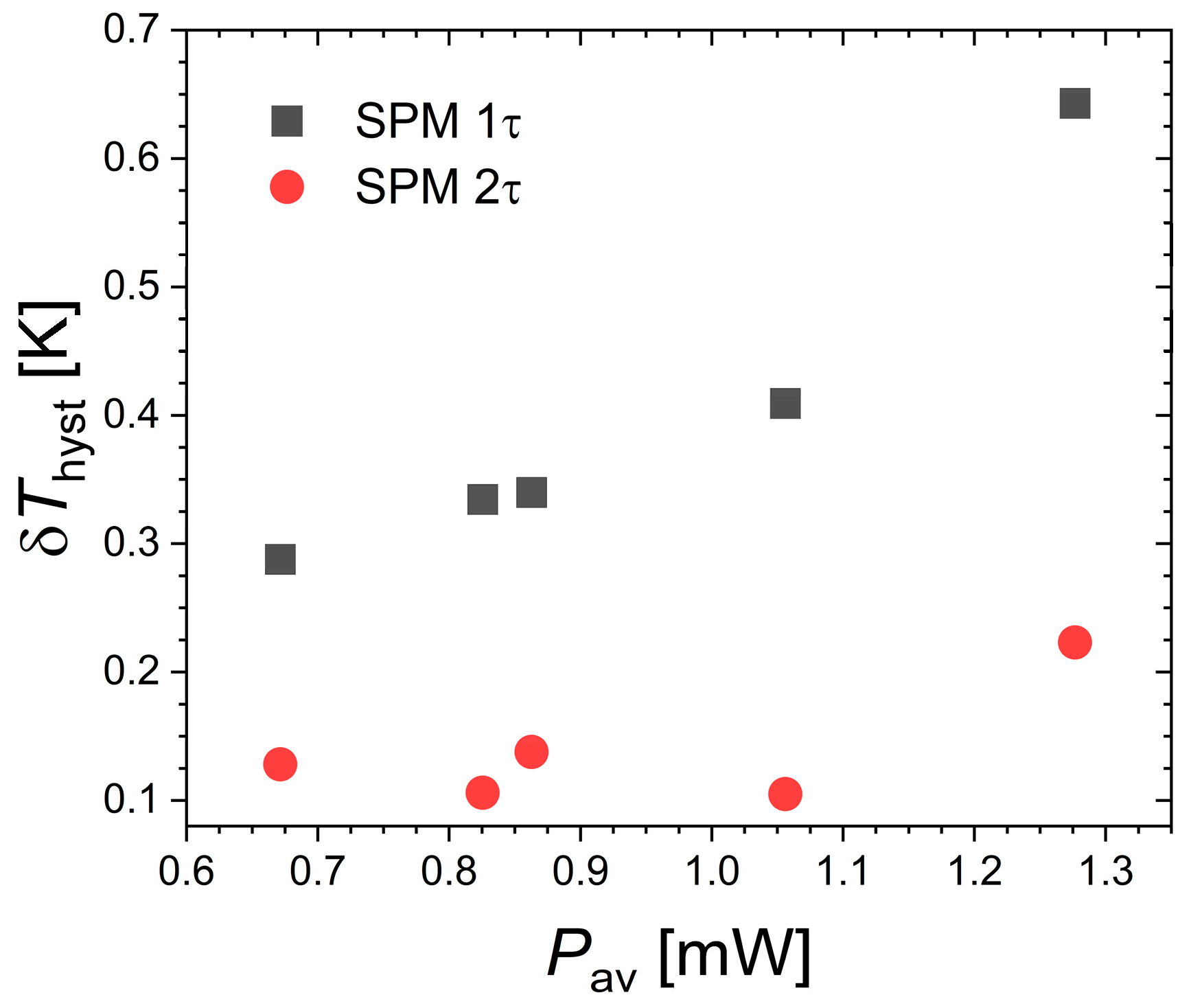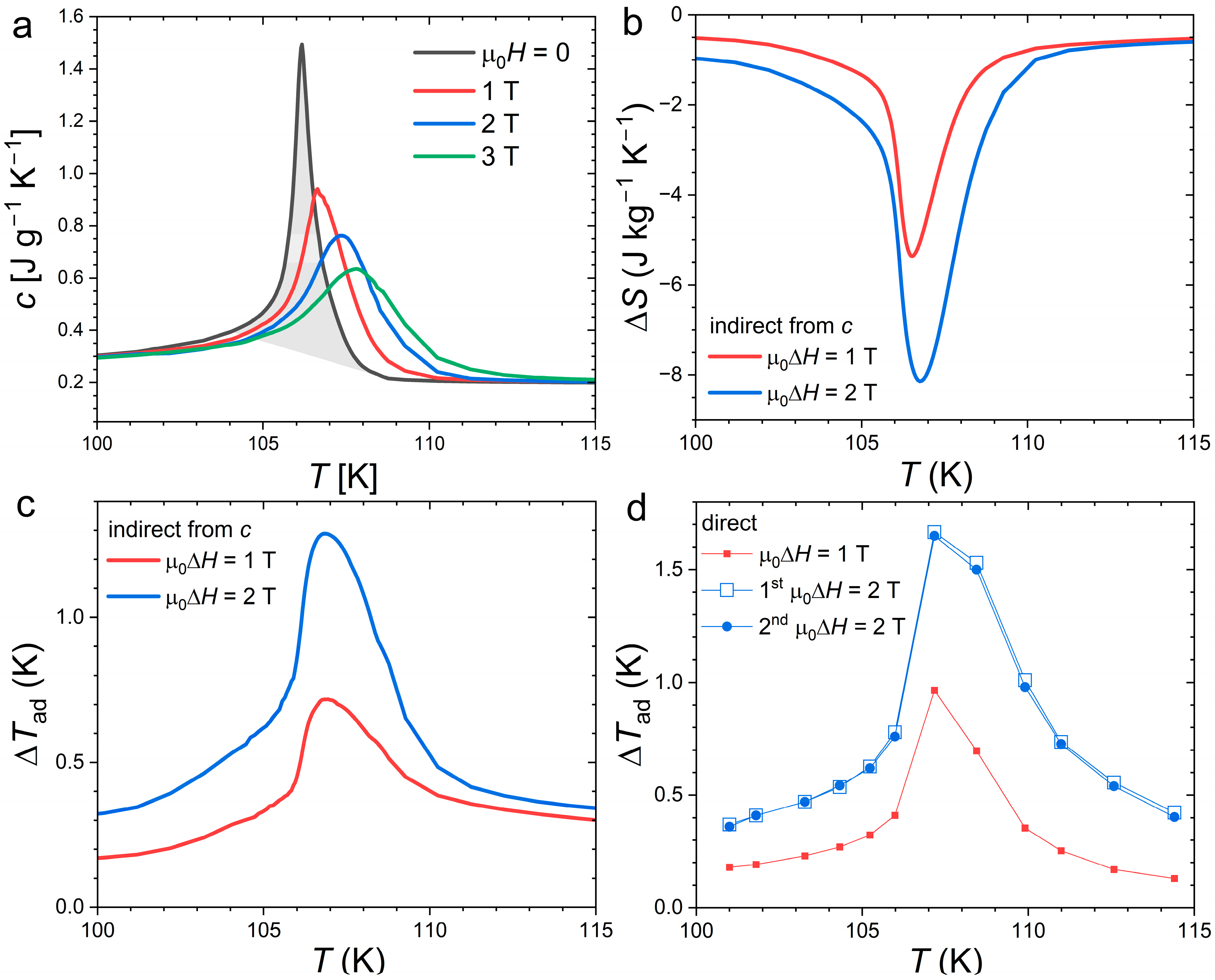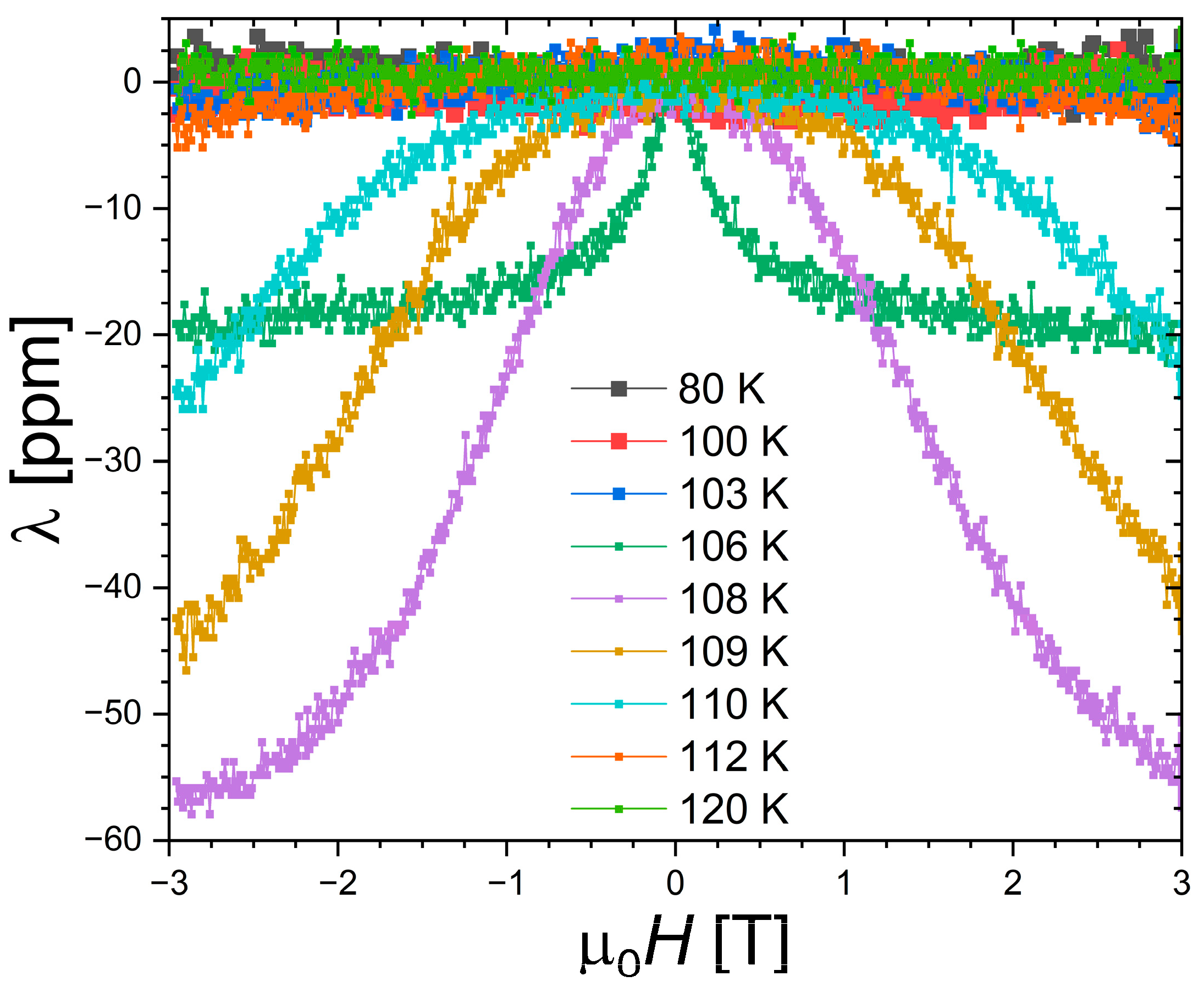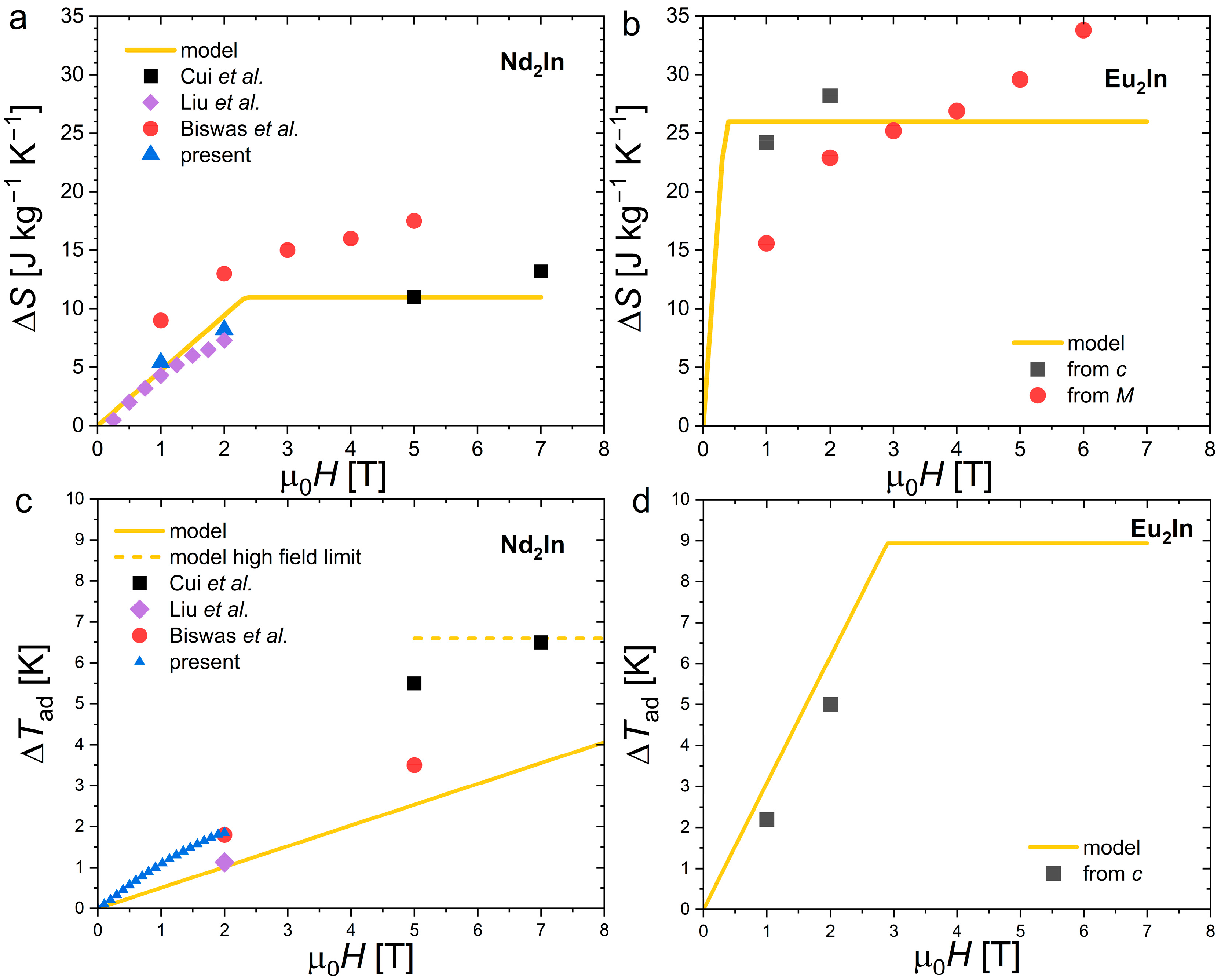1. Introduction
Rare-earth indium
R2In compounds form a relatively large materials family with intriguing magnetic properties; members of this family have recently attracted researchers’ interest due to their potential magnetocaloric applications.
R2In compounds based on trivalent rare earths crystallize in a hexagonal Ni
2In-type crystal structure (space group P6
3/mmc) featuring two inequivalent rare earth sites with distinct coordination geometries [
1]. Meanwhile divalent-like Eu
2In and Yb
2In compounds crystallize in a Co
2Si-type orthorhombic structure (space group P
nma), also comprising inequivalent sites [
2,
3]. Most of the hexagonal
R2In with
R = Nd, Pr, Gd, Tb, Dy, Ho, Er, Tm exhibit ferromagnetism with Curie temperatures loosely following a De Gennes behavior [
4,
5]. Yet, several compounds from the series present unique features that are of particular interest. Sm
2In shows ferrimagnetic ordering with small spontaneous magnetization [
6]. Gd
2In actually presents an antiferromagnetic ground state turning into ferromagnetism through a metamagnetic transition at about 100 K [
7]. The metamagnetic transition of Gd
2In is remarkable. It is of the first-order type and can be induced by temperature, magnetic field, or pressure, but is associated with a limited latent heat and hysteresis [
8,
9,
10,
11,
12]. More recently, the search for materials for magnetic cooling and the observation of a giant magnetocaloric effect in Eu
2In involving a rather unique mechanism has triggered a renewed interest for
R2In compounds [
13,
14,
15]. Whereas the heavy rare earth shows continuous second-order ferromagnetic transitions, the light rare-earth Nd
2In and Pr
2In present first-order ferromagnetic transitions (FOMT) [
16,
17,
18,
19]. The latent heat of these FOMTs leads to isothermal entropy change (Δ
S) and adiabatic temperature change (Δ
Tad) larger than that observed for the heavy rare earth
R2In despite the lower saturation magnetization of the light rare earths [
20,
21,
22]. In combination with a broader availability of light rare earths, it makes Pr
2In and Nd
2In potential magnetocaloric materials for cryogenic cooling with performances on par or greater than those of other magnetocaloric material families [
23,
24,
25,
26,
27,
28,
29], especially when looking at the temperature range relevant for the liquefaction of natural gases.
Unlike conventional FOMT materials such as Gd
5Si
2Ge
2, MnAs, FeRh, La(Fe,Si)
13 or MnFe(P,As) which exhibit crystal symmetry breaking, large volume changes or pronounced lattice distortions [
30], Nd
2In was found to be nearly structurally invariant across its magnetic transition, with a temperature-dependent crystallographic study revealing no symmetry breaking or discontinuities in lattice parameters [
19]. Its ferromagnetic transition therefore appears to be on the borderline between the first- and second-order type. As a result, while three nearly simultaneous studies have confirmed the potential of Nd
2In for use in magnetic cooling [
17,
18,
19], the exact nature of the ferromagnetic transition remains subject to debate. Using the same criteria—for instance, the shape of the heat capacity peak or the field dependence of the isothermal entropy change—the transition has been alternatively suggested to be of first- or second- order. The report of large magnetostrictive strains at the transition also contrasts with the nearly negligible volume change from temperature-dependent diffraction experiments. In addition, the thermal hysteresis of the transition shows a scatter with illustrations presenting an inverted hysteresis [
17], with reports mentioning almost no thermal hysteresis or hysteresis less than 2 K [
18,
19]. Finally, the amplitude of the magnetocaloric effect itself presents some discrepancies, with adiabatic temperature changes ∆
Tad ranging from about 1.8 K for µ
0∆
H = 2 T from indirect heat capacity measurements down to 1.13 K for µ
0∆
H = 1.95 T from direct cyclic measurements.
Since only first-order transitions can present a finite thermal hysteresis, a relatively accurate determination of the hysteresis would be needed to settle the controversies on the nature of the phase transition. The question of the hysteresis is also essential for assessing magnetocaloric performances. If thermal hysteresis is present, it would affect the reversibility of the phase transition upon magnetization/demagnetization cycles and therefore would lead to a decrease or even an absence of magnetocaloric effect after the first field application. One can actually note that a finite hysteresis could be the origin of the differences in the reported ∆Tad values, since hysteresis would affect only direct cyclic measurements. Here, we revisit the magnetocaloric effect and the ferromagnetic transition in Nd2In by using thermal measurements. We pay special attention while separating the dynamic contributions that may hinder the estimate of the thermal hysteresis during magnetic or thermal properties measurements. We observe a particularly small, yet finite, thermal hysteresis of 0.1–0.4 K. This hysteresis is found to be sufficiently limited to not result in noticeable losses during cyclic ∆Tad measurements. Finally, a descriptive parametric model is applied to shed light on the origin of the ∆Tad difference between Eu2In and Nd2In.
2. Materials and Methods
A polycrystalline Nd
2In sample was prepared by arc melting followed by heat treatment. The elemental starting materials were arc-melted 4 times in a purified Ar atmosphere while flipping the button at each iteration. The resulting button was sealed into a quartz ampule and annealed at 700 °C for 100 h. Powder X-ray diffraction measurements were carried out at room temperature using a PANalytical Empyrean diffractometer (Malvern Panalytical, Malvern, UK). The powder was crushed and sieved in an Ar-purified glovebox, then mixed with paraffin oil to prevent oxidation during the XRD measurement.
Figure 1 shows the resulting diffractogram, which can be indexed and refined using the Rietveld method in the reported hexagonal structure with lattice parameters
a = 5.5002(6) Å and
c = 6.8684(9) Å, consistent with former reports [
1,
19,
31]. In addition to a significant background present at low angle due to the paraffin oil, additional peaks are visible at 31.2° and 36.2°, which can be attributed to a cubic Nd
3In secondary phase (6.6(4)wt.%). A similar Nd
3In secondary phase was also observed in previous reports [
18,
19].
Physical properties were recorded using a Quantum Design Versalab cryostat (Quantum Design, San Diego, CA, USA). Magnetization measurements were carried out using a Vibrating Sample Magnetometry option. A homemade thermometry option close to the principle of a Differential Thermal Analyzer was used to record thermograms across the phase transition. This DTA was built by fixing two thermal sensors (one for sample, one for reference) at the extremities of two conic pillars made of PLA on a blank Versalab puck. Sample and reference temperatures were read by using bare chip Cernox sensors (CX-1070-BC-HT, Lake Shore Cryotronics, OH, USA) with a fast response time and limited thermal dilution (sensor mass << sample mass). The sensor resistivity yielding the temperature after calibration was recorded using a built-in Quantum Design Electrical Transport Option, with the same excitation amplitude (1 mA) and different frequencies (15.26 and 21.36 Hz, respectively) for sample and reference channels. Similar sensors and electronics, mounted on a different sample holder, were found to be effective in recording thermal events associated with FOMT. This included capturing fine burst-like features that developed during the transition, as observed in La(Fe,Co,Si)
13 giant magnetocaloric materials [
32].
Direct ∆
Tad measurements were carried out using the DTA hardware by sweeping the magnetic field at a rate of µ
0d
H/d
t = 1.8 Tmin
−1 in high-vacuum conditions. For ∆
Tad measurements at µ
0∆
H = 2 T, the initial temperature before field application was reached after a zero-field cooling from the paramagnetic state, and two successive magnetization/demagnetization cycles were recorded. For ∆
Tad (µ
0∆
H = 1 T), only cyclic Δ
Tad were recorded (no ZFC). The sample for ∆
Tad measurement is relatively large (1.101 g) and the thermal exchanges are limited, so that appropriate adiabatic conditions are ensured during the magnetic field change. If a single field application is applied, the subsequent exponential thermal relaxation of ∆
Tad to the initial temperature shows a typical relaxation time constant of ~30 min, which is considerably longer than the actual ∆
Tad measurement time. The robustness of this Δ
Tad setup without extraction was confirmed by measuring a Gd reference sample. The resulting ∆
Tad = 3.06 K for µ
0∆
H = 1 T was found to be slightly lower, yet within 4% of direct measurements using rotative magnetic field with µ
0d
H/d
t ≈ 1 Ts
−1 on Gd samples of similar purity [
33].
Heat capacity measurements were carried out using a Quantum Design heat capacity option equipped with a vertical puck kit. The built-in 2τ analysis is used for measurements between 50 and 200 K and complemented by Single-Pulse Measurements (SPMs) near the Curie temperature [
34]. Since Differential Scanning Calorimetry is often considered as the most suitable technique for recording the latent heat of FOMT, a complementary DSc measurement was carried out on Nd
2In.
Figure 1 presents the measurements carried out near the FOMT using a homemade Peltier cell DSC for a Quantum Design cryostat [
32]. The integration of the
c/
T peak subtracted by a linear background yields a transition entropy change of 10.9 J kg
−1 K
−1.
Dilatometry measurements were carried out using a homemade strain gauge option. ZEMIC BAB-120-3AA250(11) (Xi’an, China) strain gauges were bonded with H-610 epoxy on a polished 9 × 9 × 5 mm3 bulk piece of Nd2In and a fused silica reference sample. A Keithley 2400 source meter unit was used for the voltage excitation of the Wheatstone bridge and a Keithley 2182A nanovoltmeter was employed to record the output voltage signal; both were controlled via a 2018LabVIEW interface (Tektronix, OR, USA). Prior to the measurement, a Cu metal reference (Puratronic, 99.999%, Alfa Aesar, MA, USA) was measured by using gauges originating from the same batch (and the same glue). At T = 293 K, the measured linear thermal expansion for the cupper, 16.8 ppmK−1, was in line with the expected value and over the whole temperature range (50–350 K), deviations from the NIST reference values did not exceed 2.5%.
3. Results
Figure 2 presents magnetization measurements as a function of the temperature near the Curie temperature of Nd
2In. In line with former reports [
4,
5,
17,
18,
19], a relatively sharp drop in magnetization is observed at about 108 K. As the present study is devoted to the main ferromagnetic transition in Nd
2In, the comparatively minor magnetic anomaly usually observed at lower temperature is not investigated (spin reorientation transition near ~50 K) [
17,
18,
19]. At the ferro–paramagnetic transition, a finite thermal hysteresis is observed between measurement upon heating and cooling. However, this dataset, recorded at different sweeping rates, successfully illustrates the difficulty of separating the intrinsic thermal hysteresis of the phase transition from the thermal lag inherent to dynamic measurements. At the lowest rate (0.1 Kmin
−1), a finite thermal hysteresis δ
Thyst ≈ 0.18 K is observed. This value turns out comparable with the exceptionally small hysteresis δ
Thyst ≈ 0.1 K at the first-order ferromagnetic transition of Eu
2In [
13] and one order of magnitude smaller than typically observed in archetypical giant magnetocaloric materials with optimized hysteresis, such as La(Fe,Si)
13 or MnFe(P,Si) [
35,
36,
37].
Unfortunately, magnetic data achieved with finer control of the temperature—for instance, by stabilizing the temperature at each temperature point—would not yield a more accurate estimate of the hysteresis. Typically, during the thermalization to a new temperature, the cryostat stabilizes through decaying thermal oscillations around the target temperature. If the amplitude of these oscillations is on par with the thermal hysteresis, the thermomagnetic history of the sample can no longer be tracked. Different measurement protocols, particularly different sweeping rates, are likely responsible for the scatter in the reported thermal hysteresis values for Nd
2In [
17,
18,
19]. To obtain a more reliable estimate of δ
Thyst, we turned to methods which involved taking a direct reading of the actual sample temperature during the measurements. For instance, DTA is one of the most traditional methods for detecting phase transitions.
Figure 3 presents DTA thermograms at different sweeping rates in Nd
2In. A thermal anomaly marks out the ferromagnetic transition near 108 K, but it corresponds to a relatively broad feature, without a clear plateau of constant temperature expected due to the latent heat of a first-order transition. Yet, the DTA vs. T curves still correspond to a notable peak. Even if the thermal sensor is connected (by using grease) to the sample, measurements at different rates allow a progressive dynamic contribution to appear. The smallest measured hysteresis is δ
Thyst ≈ 0.38 K, which extrapolates to the range 0.4–0.2 K for static conditions.
If DTA is well suited to detecting phase transitions while offering a broad dynamical range, it provides only a limited accuracy for quantitative analysis. Specific heat measurements were therefore carried out by using the standard analysis of the heat capacity option of a Quantum Design cryostat from 50 to 200 K in various magnetic fields and complemented by the Single-Pulse Method (SPM) near the Curie temperature. SPM involves applying large heat pulses to fully cross the transition, and it offers a better temperature incrementation, allows the separation of heating and cooling branches, and allow us to overcome the limitations of the built-in 2τ method [
34,
38,
39,
40].
Figure 4 presents the specific heat peak measured by SPM at the Curie temperature of Nd
2In. First, one can note that the thermal anomaly associated with the FOMT is relatively successfully captured by the SPM method, as it yields a peak maximum of ~1.5 J g
−1 K
−1 comparable to DSC measurements presented in
Figure 1. We also observe that the peak marking the transition is rather symmetric. A Gaussian distribution of latent heat centered on the transition temperature is typical of first-order transitions and contrasts with the lambda-like anomaly of second-order transitions. The improved temperature resolution offered by SPM allows us to accurately describe the specific heat event, which may explain the difference compared to the original report on Nd
2In concluding on a lambda-like anomaly [
15]. When analyzed in a 1τ model considering the sample and platform as a single system in perfect thermal contact, the specific heat is expressed as a function of the platform temperature (
TP). By selecting a different bath temperature (
T0) and targeted pulse temperature range, different amounts of heat power can be applied. Increased heat power leads to a faster crossing of the transition and also results in an apparent increase in thermal hysteresis between the peak upon heating and cooling as a function of
TP, corresponding to δ
Thyst in the range 0.29 to 0.64 K for the explored SPM parameters.
The increase in δ
Thyst with the applied heat again illustrates the difficulty of estimating the thermal hysteresis even in experimental setups in which the thermometer is in contact with the sample. To take into account the thermal lag between sample (
TS) and platform (
TP) temperatures, one has to involve a second heat balance which accounts for a finite conductance of the grease [
34,
38,
39,
40]. The thermal lag
can be estimated using the grease
Kg and wire
Kw conductance determined by extrapolation of the 2
τ fittings before and after the transition.
Figure 4 illustrates the difference between the raw data as a function
TP and the corrected data vs.
TS and
Figure 5 summarizes δ
Thys from the peak maxima for the different pulses. Correcting for thermal lags leads to a reduced, yet non-vanishing, hysteresis of 0.1 to 0.2 K. However, the thermal lag correction, and therefore hysteresis, is highly sensitive to the estimation of
Kg, which is a parameter that is indirectly estimated. Unfortunately, independently measuring or calibrating
Kg is challenging as it depends on the amount of grease and the sample positioning, both of which are difficult to reproduce between different measurements. It should be noted here that a reduction in
Kg by 40% would be required to cancel out the hysteresis, which at first glance seems rather unlikely.
Figure 6 presents measurements of the specific heat in applied magnetic fields and the corresponding determination of the magnetocaloric effect as well as a comparison with direct Δ
Tad measurements. The transition entropy change was estimated by integration of the specific heat using a linear background yielding a value
10.8 J kg
−1 K
−1. A comparable estimate (10.9 J kg
−1 K
−1) was obtained using DSC data, as shown in
Figure 1, which confirms the reliability of the present specific heat data even at the FOMT. In addition to measurement techniques, estimating the transition entropy is actually made tricky by the selection of the starting and end points of the transition. Here, even when considering a temperature window of 4 K, which is relatively large with regard to the ~0.7 K full width at half maximum of the peak, the Δ
Str in Nd
2In appears thrice smaller than that found in orthorhombic Eu
2In (Δ
Str ≈ 27.5 J kg
−1 K
−1 [
13]) indicating a significantly weaker FOMT.
The application of a magnetic field yields a pronounced broadening of the specific heat peak, which highlights the relatively weak character of the FOMT in comparison to strong latent heat system for which the peak intensity is more robust upon high field application. The shift in the transition due to the field estimated from the specific heat maxima in different fields is linear and yields a relatively modest
. The isothermal entropy change indirectly derived from calorimetry data corresponds to a maximum of −8.2 J kg
−1 K
−1 for µ
0Δ
H = 2 T, well within the range of previously reported values (from −7.42 to −13 J kg
−1 K
−1 [
17,
18,
19]). The adiabatic temperature change was estimated by indirect specific heat measurements at 1.3 K for 2 T. Similarly to Δ
S, the Δ
Tad performances are found to be intermediate among the previously reported results [
17,
18,
19].
More specific to our study, we performed direct ∆
Tad measurements at the first magnetization after zero field cooling and upon further demagnetizing/magnetization cycles. The differences between the first and second magnetizing measurements turned out to be insignificant (differences of 0.03 K or less), demonstrating that the MCE is nearly fully reversible upon cycling, even at an intermediate applied magnetic field of 2 T. The Δ
Tad from direct measurement reaches 1.68 K for 2 T, which is apparently larger than that found from indirect measurements. The difference may originate from the uncertainty of each technique. In particular, the indirect method suffers from several possible sources of error, such as underestimating the latent heat, cumulative errors during the entropy integration, and starting the integration from a temperature different from 0 [
41,
42].
Thermal expansion and magnetostriction of Nd
2In are presented in
Figure 7 and
Figure 8, respectively. In line with former dilatometry or temperature-dependent XRD experiments [
17,
18,
19], the ferromagnetic transition does not correspond to a significant discontinuity, but is fingerprinted by the appearance of a negative spontaneous magnetostriction. The absence of marked anomaly contrasts with the large volume or cell parameter changes usually observed at the FOMT of giant MCE materials. In the paramagnetic state, above 150 K, the thermal expansion α
L ≈ 8.5 ppmK
−1 is rather linear and is in line with that observed from powder XRD, α
V ≈ 28 ppmK
−1 [
19]. Below
TC, the linear expansion is larger and amounts to α
L ≈ 9.8 ppmK
−1.
A close inspection of the thermal expansion near the ferromagnetic transition reveals a small bump and a finite thermal hysteresis. Both features are strongly suppressed by reducing the sweeping rate, suggesting they mainly originate from sample thermalization. At the slowest rate of 0.25 Kmin−1, a thermal hysteresis of δThyst ≈ 0.4 K is observed.
Longitudinal magnetostriction measurements were carried out at selected temperatures, below, at, and above the ferromagnetic transition. In the ferromagnetic state, the forced magnetostriction is small (≈2 ppm for 3 T at 80 K). A finite negative longitudinal magnetostriction appears near the phase transition, with an S-shape just above
TC, mimicking the magnetization of a field-induced FOMTs. This magnetostriction quickly vanishes when the temperature is raised (or requires significantly larger magnetic field to be induced), and become negligible (≤1 ppm) in the paramagnetic state above 120 K. Qualitatively, the presently observed temperature dependence of the magnetostriction is in overall agreement with the former two reports [
17,
18]. Quantitatively, however, one can note some notable differences. In ref. [
18] employing strain measurements as a function of the temperature in different magnetic fields, a negative magnetostriction was observed only in applied fields of 8 T and more. Here, finite negative magnetostriction is observed at intermediate fields of 1 or 2 T during isothermal measurements. Differences in thermalization might influence the observation of subtle magnetostrictive features. With a progressive saturation just above
TC at −58 ppm for 3 T, the amplitude presently observed is significantly smaller than the giant saturation magnetostriction of ~450 ppm reported in ref. [
17].
4. Discussion
As pointed out by Biswas et al. [
19], the classification of the Nd
2In ferromagnetic transition into first- or second-order transition has turned out to be tricky. The absence of noticeable discontinuity on the thermal expansion suggests a continuous transition, whereas the rather symmetric heat capacity peak is more typical of a FOMT. In this context, the presence of a thermal hysteresis distinctive of FOMT is important. But, as illustrated here, hysteresis is also particularly challenging to measure with a reasonable accuracy, which is the primary reason for the scatter among the reported values for Nd
2In. Magnetization, DTA, specific heat, and dilatometry performed at different rates suggest a finite δ
Thyst, but of exceptionally small amplitude of 0.1 to 0.4 K, comparable to that observed in Eu
2In [
13]. While Nd
2In definitively lays at the first-/second-order boundary, the persisting finite hysteresis suggests this ferromagnetic transition is more likely to be a FOMT.
Giant saturation magnetostriction [
17] or field-induced transition processing in two stages on strains [
18] were not observed. Some aspects of the magnetostriction of Nd
2In therefore remain elusive and would require further investigation. One can, however, point out that the absence of thermal expansion anomaly at the transition is, at first glance, in line with the modest longitudinal magnetostriction presently observed at
TC.
The very limited thermal hysteresis leads to nearly identical Δ
Tad between measurements after a ZFC and those measured in cyclic conditions. The scatter in reported Δ
Tad values for Nd
2In does not, therefore, originate from irreversibility. It most likely involves the uncertainty inherent to the Δ
Tad measurement methods and the sample preparation; in particular, parameters influencing the sharpness of the transition such as the raw materials’ purity or the sintering conditions. However, no direct relation can be established between phase purity and magnetocaloric performances, as Δ
S or Δ
Tad do not appear to scale with the Nd
3In weight fractions in the various studies. For instance, our sample appears to suffer from the largest Nd
3In contamination, but the presently observed Δ
Tad ≈ 1.7 K for 2 T are intermediate values among the different reports on Nd
2In [
17,
18,
19]. The magnetocaloric effect of Nd
2In is significant compared to other materials in this temperature range, but it remains notably smaller than Δ
Tad ≈ 5.0 K for 2 T found in the closely related Eu
2In [
13].
Figure 9 summarizes the experimental Δ
S and Δ
Tad data available for both compounds in different magnetic fields, and a parametric latent heat model used for their interpretation.
Among the various approaches which can be used to predict the magnetocaloric effect, a parametric “latent heat” method can appropriately describe the giant magnetocaloric effect with FOMT. This model consists of describing the shift in the entropy discontinuity of a FOMT due to the application of a magnetic field [
43,
44,
45,
46,
47,
48]. At high magnetic fields, when the transition is fully induced, Δ
S corresponds to the entropy change in the transition Δ
S = Δ
Str and correspondingly Δ
Tad =
TCΔ
Str/
cback, where
cback is the specific heat background outside the transition. Below their respective saturating fields, Δ
S = Δ
Str[Δ
H(d
Ttr/d
H)]/δ
Ttr and Δ
Tad = Δ
H(d
Ttr/d
H)[1 − δ
Ttr/(Δ
Str/
cback + δ
Ttr)] are dependent on the magnetic field change (Δ
H) and can be expressed as a function of several externally measured parameters such as the shift in the transition due to field (d
Ttr/µ
0d
H) or the width of the transition (δ
Ttr) [
43,
44,
45,
46,
47,
48]. While it is advantageous to describe giant MCE
s, this model neglects the magnetocaloric contributions that do not originate from the FOMT (the magnetocaloric effect due to application of the field on the paramagnetic and ferromagnetic fractions below and above the FOMT).
Table 1 summarizes the parameters used to model Nd
2In and Eu
2In in
Figure 9.
Applying the model to the case of Nd2In and Eu2In yields only a modest agreement with the experimental results. But the apparent deviation also originates from the large scatter on the experimental values. One is thus limited to a discussion of the overall tendencies which remain relatively well captured by the model. Regarding ΔS, the larger ΔStr for Eu2In than Nd2In favors significantly larger ΔS at high fields. In addition, large ΔS values are reached sooner in Eu2In than Nd2In at intermediate fields (1 T). While both compounds present very sharp transitions, the difference primarily originates from the greater sensitivity to the magnetic field in Eu2In (dTtr/µ0dH), which is nearly six times larger than that presently observed in Nd2In. The Clausius Clapeyron relation dTtr/µ0dH = −ΔM/ΔStr implies that this larger dTtr/µ0dH mostly originates from the larger magnetization change at the transition. ΔM is a parameter involving extrinsic aspects such as the sharpness of the transition, but it is also bounded by the saturation magnetization which is primarily attributed to the nature of the rare earth in these compounds. With gJ = 7 μB for Eu2+ in comparison to 3.27 μB for Nd3+, Eu2In shows a twice larger saturation magnetization and an even greater ΔM than Nd2In due to its more pronounced FOMT characteristics.
Noting that the specific heat outside the transition cback is relatively high for both Nd2In and Eu2In, it negatively affects the ΔTad to a similar extent. Greater dTtr/µ0dH also favors larger ΔTad in Eu2In at intermediate fields. High field ΔTad measurements on Eu2In would, however, be needed to expand the comparison.
